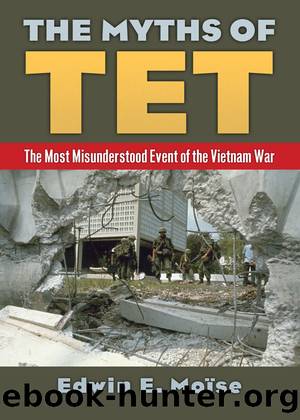The Myths of Tet: The Most Misunderstood Event of the Vietnam War by Edwin Moise

Author:Edwin Moise [Moise, Edwin]
Language: eng
Format: epub
ISBN: 9780700625031
Publisher: University Press of Kansas
Published: 2017-11-21T07:00:00+00:00
THE RAND INTERVIEWS
The Rand Corporation (on contract for the US Department of Defense [DoD]) did a series of eighty-two interviews with Communist personnel in South Vietnam who had been captured or had turned themselves in (âralliedâ) to RVN authorities between January and May 1968. More than half had participated in the Tet Offensive. The version that was declassified and released to the public in 1972 was sanitized, with not only personal names but also locations and the identities of both Communist and RVN organizations and units blacked out,22 but still, the interview texts are a valuable source of information. It is sometimes possible to figure out what a deleted place name must have been.
As the interviewers were aware, the interview subjects were not always candid. In addition, they clearly did not constitute a representative sample of the participants in the Tet Offensive. For one thing, the subjects were predominantly North Vietnamese. While it is likely that there were more northerners in the offensive than common stereotypes suggest, there cannot have been that many. MACV estimated that the regular combat troops in the offensive were about 70 percent Viet Cong,23 though it is not clear how North Vietnamese âfillersâ in Viet Cong units were treated in this computation.
Other biases in the sample arose from the logic of the situation. North Vietnamese whose superiors had given them a grossly exaggerated picture of the strength of the revolution in South Vietnam, and who had been shocked to learn the truth, were probably overrepresented because they would have been more likely to rally to the government than those whose superiors had been more honest. And the members of units whose attacks had gone disastrously wrong were more likely either to have been taken prisoner or to have rallied than the members of units whose operations had gone better.
The interviews give a good picture of the ways an attack could go wrong in the Tet Offensive. Most of these were connected, in one way or another, with the fact that so many people had been given little or no time to prepare for their missions.
Most were not given time to study their targets and memorize the layout of the defenses. Before attacking a position with fences and guard towers, they should have been shown a model on a sand table so they could consider what weak points it had and how they could be approached. A few were given that opportunity,24 but not many. Some, moving toward their targets during the night of January 30â31, had not even a vague notion of where they were going. Only as they were approaching their target, which happened in darkness if they were even close to being on schedule, were they told what it was. This obviously precluded a detailed briefing about the layout.25 A battalion commander described his planning for his unitâs attack on the town of Pleiku: âActually I didnât know anything about the situation and the terrain of the town. Generally, we all knew that the town had a lot of houses and streets, etc.
Download
This site does not store any files on its server. We only index and link to content provided by other sites. Please contact the content providers to delete copyright contents if any and email us, we'll remove relevant links or contents immediately.
| Africa | Americas |
| Arctic & Antarctica | Asia |
| Australia & Oceania | Europe |
| Middle East | Russia |
| United States | World |
| Ancient Civilizations | Military |
| Historical Study & Educational Resources |
Magic and Divination in Early Islam by Emilie Savage-Smith;(1194)
Ambition and Desire: The Dangerous Life of Josephine Bonaparte by Kate Williams(1084)
Operation Vengeance: The Astonishing Aerial Ambush That Changed World War II by Dan Hampton(985)
What Really Happened: The Death of Hitler by Robert J. Hutchinson(867)
London in the Twentieth Century by Jerry White(844)
Time of the Magicians by Wolfram Eilenberger(842)
Twilight of the Gods by Ian W. Toll(810)
The Japanese by Christopher Harding(795)
Papillon by Henry Charrière(792)
Lenin: A Biography by Robert Service(777)
The Devil You Know by Charles M. Blow(777)
Twelve Caesars by Mary Beard(764)
Freemasons for Dummies by Hodapp Christopher;(747)
The Churchill Complex by Ian Buruma(729)
Napolean Hill Collection by Napoleon Hill(701)
The Enlightenment by Ritchie Robertson(690)
Henry III by David Carpenter;(685)
Bohemians, Bootleggers, Flappers, and Swells: The Best of Early Vanity Fair by Bohemians Bootleggers Flappers & Swells- The Best of Early Vanity Fair (epub)(680)
The Rise and Triumph of the Modern Self by Unknown(653)
